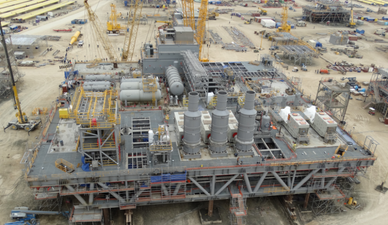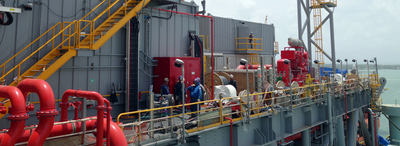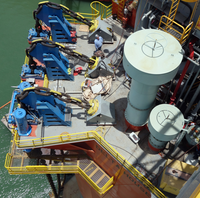Fast-track Platform Success: The Story Behind Delta House FPS
Apr|27|2017

This is the first blog post in our three-part series on the award winning Delta House FPS.
Offshore production operations present some of the most difficult logistical, technological, and financial challenges facing the oil & gas industry today. Adding to the challenge of offshore production operations is the fact that companies are being asked to adhere to increasingly aggressive project schedules. With the Delta House FPS in the Gulf of Mexico (GoM), this was exactly the case.
In an effort to exploit deepwater reserves that were at one time considered inaccessible, operators throughout the globe are designing and building floating production systems (FPS) that test the bounds of engineering and construction.
Installed at a water depth of 4,500-ft, approximately 130-miles southeast of New Orleans, Delta House FPS is a testament to the growing trend of independent (and often privately-funded) companies taking their shallow water methodologies into deeper waters that have long been dominated by well-capitalized majors. The facility is part of the Delta House Field Development Project — a joint venture between LLOG Exploration L.L.C. and Blackstone Energy Partners that involves the drilling of wells in the Mississippi Canyon.

HOW DELTA HOUSE FPS BEGAN
In 2010, LLOG acquired approximately 20 deepwater leases in the Gulf of Mexico’s Mississippi Canyon Block 254. There was a caveat though. Drilling had to begin within 36 months or the leases would expire. So with time running out, LLOG hired Lounsbury Associates Companies (topsides engineering contractor) to design the facility and get production assets on station and ready for first oil. Other key contractors that worked on project included EXMAR Offshore, the hull design company; Kiewit Offshore Services (KOS), the topsides integration and lift contractor; and Pinnacle Engineering, the subsea engineering company.
"Delta House is a testament to the growing trend of independent companies taking their shallow water methodologies into deeper waters."
AN UNCONVENTIONAL APPROACH
Most “Big Oil” FPS developments follow a traditional, time-honored approach of drilling delineation wells and studying reservoir characteristics after a discovery is made. This is then followed by front-end engineering design (FEED) and bid tendering. Typically, it’s only after these phases finish that detailed design and construction can begin.
With the aggressive schedule of Delta House FPS, this approach simply wasn’t feasible. In order to be ready for production before the leases expired, engineering and construction began before the reservoir characteristics were known. As a result, the facility had to be developed in such a way that it would be able to handle a very wide range of hydrocarbon profiles. Although the approach was risky, LLOG felt that the benefits of reaching production within the specified timeframe greatly outweighed the potential downside of having a platform that that was not customized to the exact characteristics of the reservoirs from which it would be extracting the hydrocarbons.

LLOG also felt that the timeline for production at Delta House would be shorter than that of comparable platforms operated by most majors due to the extensive amount of detailed requirements that larger companies have for their offshore facilities. Although it was imperative to meet and/or exceed all industry standards, along with regulations set forth by applicable authorities, including the Bureau of Safety and Environmental Enforcement (BSSE) and the Coast Guard, the company believed that they could streamline regulatory work by developing a set of requirements that were specific to Delta House.
Overall, Lounsbury Associates Companies and LLOG estimated that by taking this unconventional approach, first oil could be achieved 2 to 3 years sooner than what’s typically seen on similar production platforms throughout the Gulf of Mexico (GoM).
"The facility itself is a reflection of how the industry is ushering in new advances to cope with the challenges of offshore production."
A FLEXIBLE DESIGN
With virtually no concrete data on reservoir characteristics, Lounsbury Associates Companies implemented a flexible “one size fits most” design philosophy that enabled the platform to handle a wide range of hydrocarbon profiles and production rates.
The facility is designed to work with crude ranging from 28 to 37° API; however, it can work outside that range with some cost to capacity. It was designed for a name plate capacity of approximately 80,000 b/d oil, 200 MMcf/d of gas, and 40,000 b/d of water. In the event that processing requirements exceeded these figures, it was determined by LLOG that it would be more economical to build a second platform than it would be to expand the capabilities of Delta House FPS.
The platform also featured a “Texas style” single-level topsides design, which allowed for construction activities to be conducted on the ground and then hoisted into place on the columns in a single lift. Being able to perform the equipment installation and the fitting of utilities, such as pipes and cabling on the ground was easier, safer, and cheaper than having to do it 75-ft above the water.
Delta House FPS is currently in operation, having produced first oil in April 2015 — nearly two full years earlier than what’s typically seen from comparable platforms in the GoM. The facility itself is a reflection of how the industry is ushering in new advances to cope with the challenges of offshore production.
Although the methodologies used to build the platform will not work for all circumstances, the lessons learned from Delta House will pave the way for the development of more flexible designs that are able to meet the increasingly complex demands of the offshore oil and gas industry.
